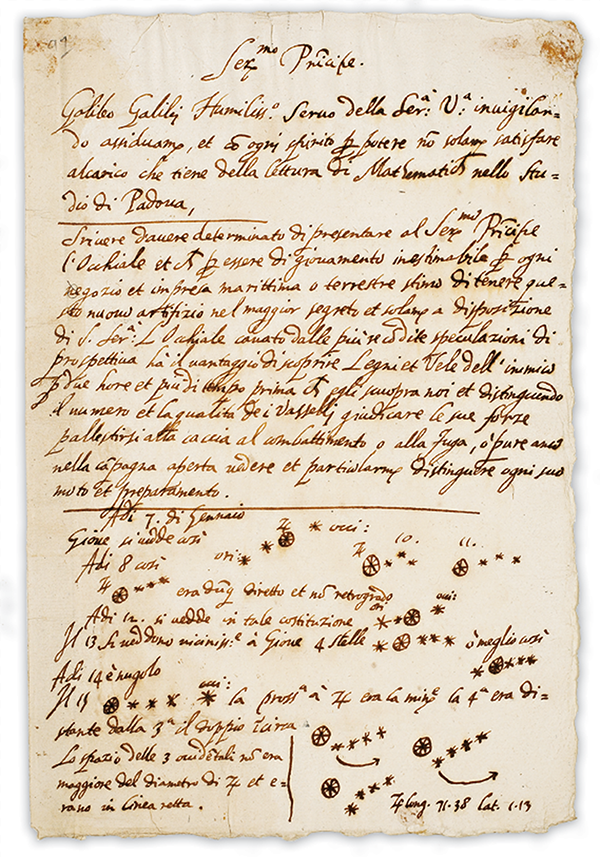- About MAA
- Membership
- MAA Publications
- Periodicals
- Blogs
- MAA Book Series
- MAA Press (an imprint of the AMS)
- MAA Notes
- MAA Reviews
- Mathematical Communication
- Information for Libraries
- Author Resources
- Advertise with MAA
- Meetings
- Competitions
- Programs
- Communities
- MAA Sections
- SIGMAA
- MAA Connect
- Students
- MAA Awards
- Awards Booklets
- Writing Awards
- Teaching Awards
- Service Awards
- Research Awards
- Lecture Awards
- Putnam Competition Individual and Team Winners
- D. E. Shaw Group AMC 8 Awards & Certificates
- Maryam Mirzakhani AMC 10 A Awards & Certificates
- Two Sigma AMC 10 B Awards & Certificates
- Jane Street AMC 12 A Awards & Certificates
- Akamai AMC 12 B Awards & Certificates
- High School Teachers
- News
You are here
Mathematical Treasure: Galileo's Compass and a Galileo Forgery
Galileo Galilei (1564–1642) wrote his works in Italian. One of his tracts that was translated into Latin for wider scientific distribution was Tractatus De Proportionum Instrumento (1612). The translator was Matthias Bernegger (1582–1640). This image is provided courtesy of the National Library of Florence (Biblioteca Nazionale Centrale di Firenze). A 1640 printing of the original Italian text is also in Convergence.

In the spring of 1609, Galileo famously built a telescope based on devices available in the Netherlands and by August improved its lens from three-powered to eight-powered. He gifted such a telescope to one of his patrons, Leonardo Donato, Doge (ruler) of Venice, and accompanied the gift with a letter; one online translation of most of the missive is here. That fall and winter, Galileo made further improvements to the telescope, saw and sketched mountains on the Moon, observed hundreds of stars that are invisible to the naked eye, and discovered the four moons of Jupiter, helping to confirm that Earth is not the center of the universe. All of this groundbreaking work appeared in his 1610 Sidereus Nuncius; copies in Mathematical Treasures may be viewed here and here.
Galileo’s rough drafts of these important historical documents would be an amazing find to historians, as the manuscripts could provide insights into how Galileo developed his ideas. For nearly a century, the University of Michigan Library thought it owned such a document. The top of the manuscript shown below appeared to be a draft of Galileo’s letter to the Doge, while the bottom of the manuscript seemed to contain Galileo's preliminary sketches of Jupiter’s moons and their relative positions. That the letter predated Galileo's January 1610 discovery of the moons apparently never troubled any of the manuscript’s many readers.
Eighty-eight years of assumptions unraveled quickly in 2022 once historian Nick Wilding began asking questions about the dating of the paper on which the manuscript is written. UM experts determined the paper was made no earlier than 1770 and further found that the manuscript was never discussed before the early 1930s, despite its obvious historical significance if it were authentic. In August, UM announced that one of its best-known treasures is a forgery; the story was covered by numerous news outlets including the Washington Post. In October 2022, Wilding and UM librarian Pablo Alvarez presented a program explaining how doubts about the manuscript’s authenticity were researched and exploring how the existence of fakes can inform the methods historians use to research and write about the past. Some of these lessons have also been summarized on the UM Library’s blog.

The images above are supplied through the courtesy of the National Library of Florence and the University of Michigan Library, as indicated.
Frank J. Swetz (The Pennsylvania State University), "Mathematical Treasure: Galileo's Compass and a Galileo Forgery," Convergence (October 2022)




